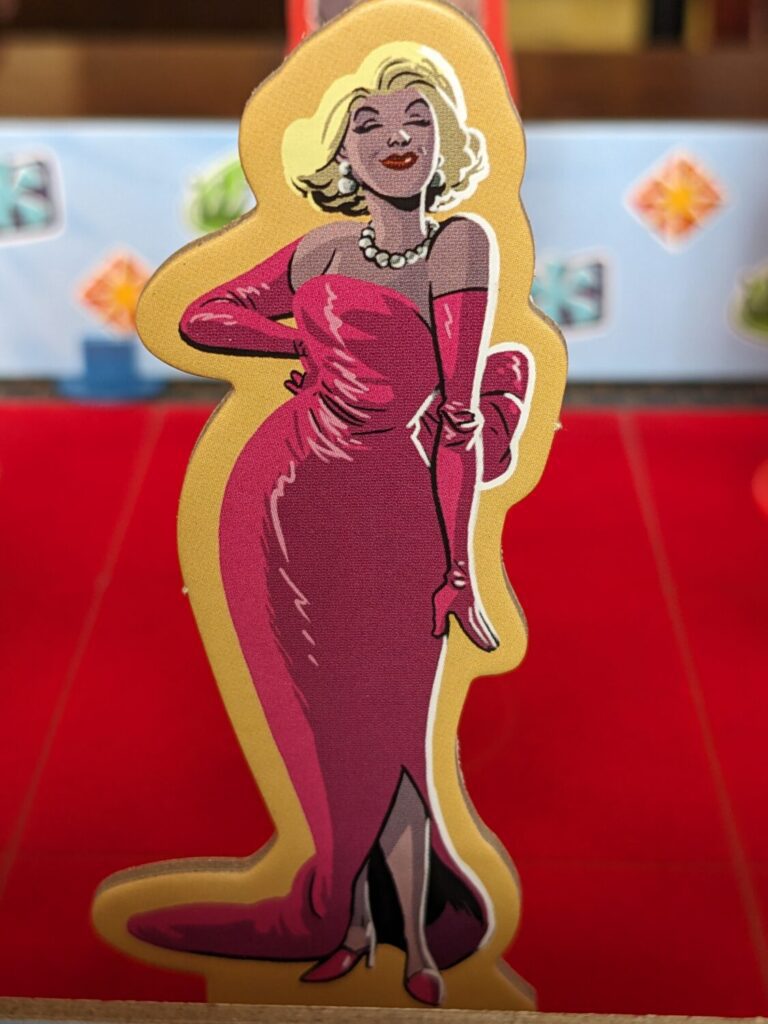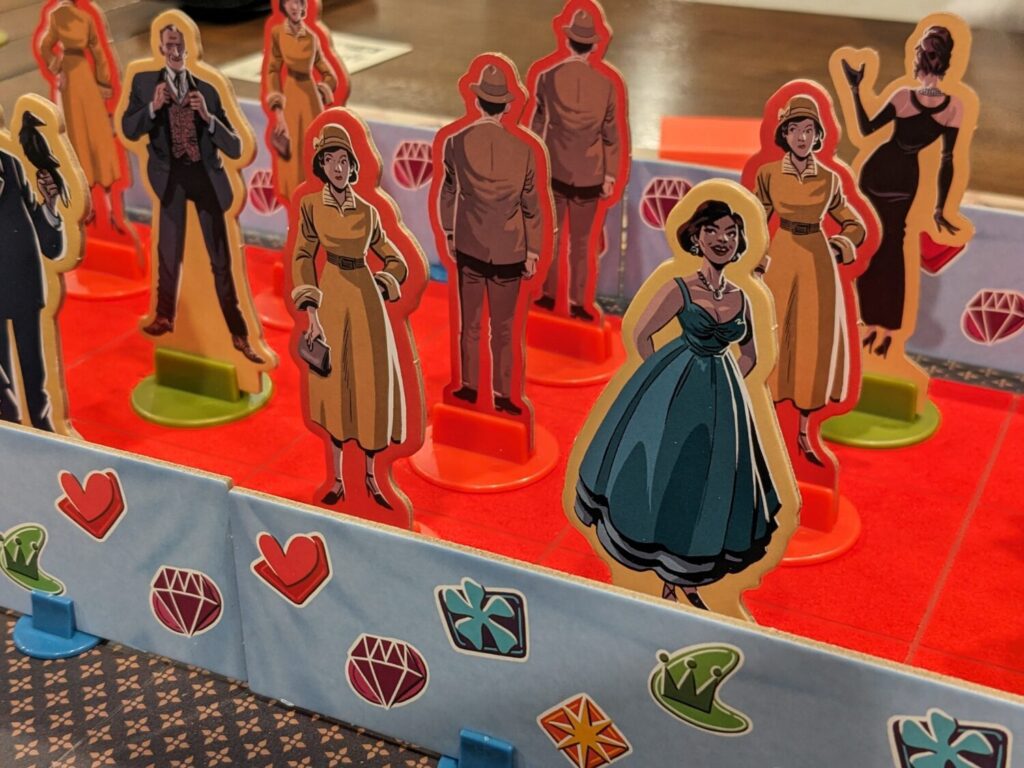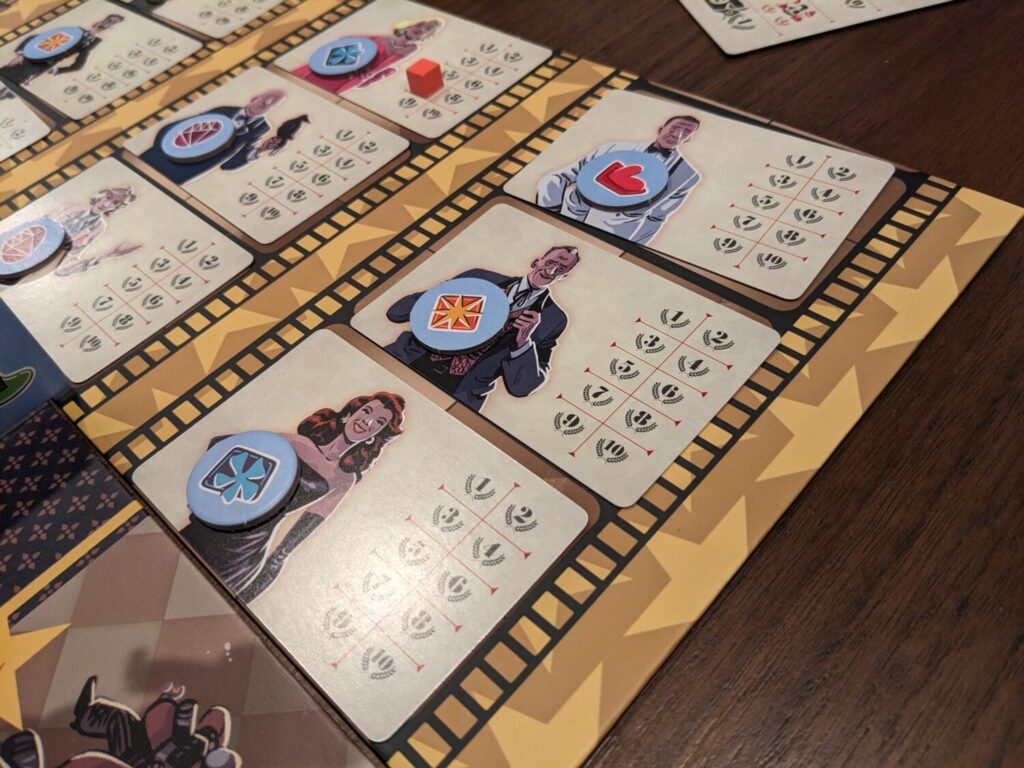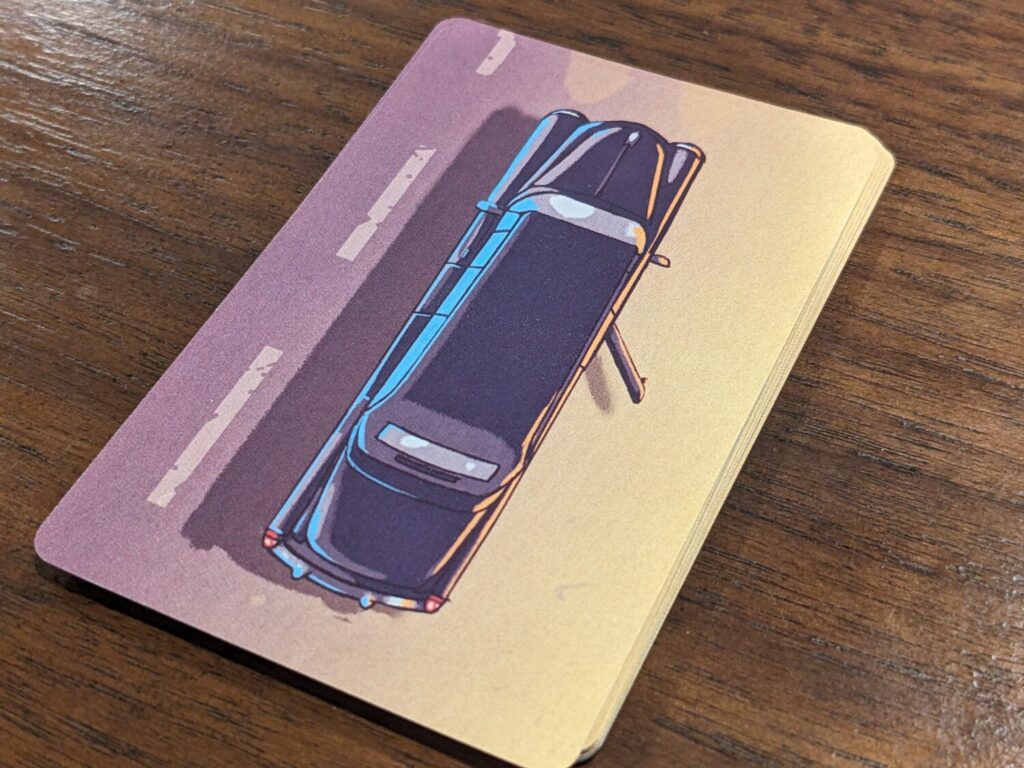Disclosure: Meeple Mountain received a free copy of this product in exchange for an honest, unbiased review. This review is not intended to be an endorsement.
I’ve never wanted to be famous. Certainly not stalked-by-the-paparazzi famous, where photographers end up perched outside my kitchen window, trying to get pictures of me eating my breakfast every day. Heck, I don’t even like the idea of being “board game famous”; sometimes, I see my content creation peers, or board game designers and publishers, being asked for autographs at conventions, and even that makes me nervous. (Yes, this is part of the reason why I will always be a tabletop media writer, not a YouTube personality.)
In the board game Red Carpet (2025, Devir Games), players take on the roles of celebrity photographers, but with a fun twist. It’s April of 1956, and outside what certainly appears to be the Academy Awards (my guess, although the rules don’t specifically say it this way), photographers must jockey for the best positions along the red carpet, to get pictures of superstars for their respective newspapers as the stars exit their limousines and make their way into the auditorium.
Even after my first play, a three-player game that included fellow Meeple Mountaineer Kev Brantley, we all agreed: whether you love the game or not, Red Carpet is going to make a sizable impression on the convention circuit this fall. That’s because the game’s table presence is excellent and everyone loves playing around with their cell phone…and here, your phone doubles as your in-game camera.

“Hey, Bogey, Look Over Here!”
Red Carpet is a quick hand management game for 2-4 players. Over the course of five rounds, the goal is simple—score the most points by taking the best pictures, ideally of the people who go on to win awards in their respective award categories at the end of the game.
Each round’s setup and execution plays out the same way. First, a limo arrives, in the form of a card that has the specific placement instructions for six people who get out of the limo: two celebrities (from a deck of ten, with two celebs entering play each round) and four entourage members, riff-raff that are so plain that generic male and female standees are used alongside the celebrity standees to illustrate the fact that entourage members are not interesting. (I love this element of the setup.)
Each standee is approximately four inches tall, placed in a standee holder that immediately gives the game a handsome, 3-D depth to its table presence. Better than that? Devir and its production team used a generic red felt to simulate the red carpet element of the board. In a game of Red Carpet, you even get a sense that those celebs are strolling down an actual red carpet.
The six figures from that limo are then placed in the first six spaces of the carpet, closest to the limo. They are facing in one of two directions, outwards towards the two photo bays on the main board. Other figures placed in earlier rounds are moved down the red carpet to accommodate these new additions, which might lead to a big crowd of major celebrities surrounded by peasants who are getting in the way of your potential cover shot.

After standees are placed, the core of the game takes place. Each player, in turn order, will play one of their five hand cards. In a round, three cards are played, then one is discarded after the third action and one is used to vote for a celebrity pictured on that card. (Voting is also an option as an action, as I will detail below.) Only after everyone has played cards will pictures of celebrities be taken to end the round.
Cards are multi-use; they can be played to do one of three things.
- A card can be played for its photo location. If burned for this effect, a player will place the tripod in their player color in one of the ten numbered locations behind the billboards that line each side of the red carpet. Once this is done, a location is booked–no other player can place their tripod in that same location, unless a player moves to a different location later. One of the three actions each round has to be this one; otherwise, a player can’t take a photo in that round.
- A card can be used to vote for the celebrity pictured on that card. At the end of the game, celebrities with the most votes by category (there are three celebrities in each of the three categories) will have their photo values doubled, meaning anyone who gets a shot of one of those folks will score a lot more points. Thematically, pictures of the eventual award winners will help sell more newspapers.
- The card can be used to move anyone–either a celebrity or an entourage member–based on the icon of the played card.
It is this final action that gives Red Carpet a devilish set of teeth, for a game that initially looks like a family-friendly “let’s take pictures of cute cardboard standees” experience. That’s because the movement options on each card can be diabolical in the hands of people who previously doubled as either friends from my game groups or even my wife. (She’s still my wife. At least, that was true at the time of this post. We are knee-deep in another game of Red Carpet, so…we’ll see.)

“Sorry About This, But, Eh…I’m Gonna Hose You”
There are three different movement options, based on the card played.
The first one allows a player to turn any standee 180°. This means that a standee who may have begun the round facing east is now facing west, towards the opposite photo bay.
Oh, did you set up your tripod on space three, hoping to get a picture of the Marilyn Monroe-a-like celebrity standee facing your camera? Bad news, the opponent who took the final action of the round decided to blow up your plans…and now you can’t take a picture at all.
The second option allows a player to “call for someone’s attention.” This can only be done if you have placed your tripod on a space, to call attention to a celebrity (or an entourage member) to have them move towards your tripod position. In a fun twist, this doesn’t make them turn towards you, so if you take this action, all it does is guarantee that a character will move one space in your direction. And if someone else does this after you, they may pull that character away from you instead.
The third one pushes one figure in a column of the red carpet area one space towards the auditorium. If any characters occupy spaces in front of the pushed character, everyone moves one space closer to the far edge of the carpet. Celebrities that are pushed off the red carpet are out of the game (they have entered the auditorium), so doing this might eliminate the opportunity to capture a picture of that celebrity. Don’t think for a second that I haven’t done this at least once in each of my plays!!

Red Carpet, which looked peaceful and friendly when you set it up, can instantly turn into a paparazzi-fueled knife fight. This knife fight is a bit more brutal for the player going first in a round, and the game’s player count mixed with the round count is way off. This is my only major issue with the design; without question, going last in a round of Red Carpet is better than going first. But in a game with five rounds, a number of things go wrong, particularly in a four-player game where one player has the chance to go last twice.
Solving this would be easy, so I recommend a house rule: playing four rounds in a two- or four-player game, or playing six rounds in a three-player game. That way, going last is handed out in equal parts and no one will use that as an excuse when they get hosed by their opponents. This would require some light juggling with the distribution of celebrities and awards, but that’s a risk I’m willing to take.
The final portion of each round is the best part: taking those pictures.
Each player takes a single picture of a celebrity they haven’t previously photographed, using their tripod (or placing their mobile phones just behind their tripod, if the phone’s case makes the tripod an issue). Points are scored in logical ways—the celebrity has to be facing you to get the most points, and ideally they are in the same row as your tripod. If the faces of any other standees are in your picture, you lose points, and in a fun twist, each celebrity was assigned a sponsor during setup in the form of a small token. The billboards on either side of the red carpet areas feature those same sponsor logos, so getting a picture of a celebrity while also getting pictures of their sponsor will score extra points. (The max you can score on a picture is 10 points before bonuses, and I’m still hunting for my first perfect 10!)
After showing off their photos to their opponents, each player then places a small cube on the score they earned for shooting a picture of that celebrity. At the end of the game, all those secret votes are added up, and a winner is declared in each of the game’s three categories. Pictures of category winners, along with the tenth and final celebrity featured in the game’s fourth category, the Lifetime Achievement award, are doubled, then final scores are tallied.

A Solid Set of Nominees
Red Carpet gets a lot of things right. It’s another “medium box” production from Devir that lands in the $30 range and can be taught and played with a group of four players in 45-60 minutes. It’s a looker from almost every angle—the cards are fantastic, the standees work even from afar, and that red felt adds just enough to the experience to make you feel like you are jockeying for position with other paparazzi of the era.
At higher player counts, the amount of change between turns can lead to real chaos; in a game like this, I don’t know how well that chaos will work for other players. For me, even at three players, the board state changed so much that planning became very difficult, particularly playing first in a round. In that way, I had less fun trying to guess what opponents might do, so I found myself intentionally settling for terrible photos when I was playing earlier in turn order. That might change with experience. In this way, I enjoyed my play at two players most—I still got to make interesting decisions, I still got to try and hose my wife with a jab each turn, and the game can be played in about 30 minutes.
But I still had interesting things to do regardless of the player count, and setting up ways to take the best pictures and try to capture the sponsor logos in each shot was a blast. Trying to ensure that I got pictures of celebs in each category to try and maximize my score was interesting, and I was surprised how often I was comfortable settling for subpar images of celebrities far from my tripod position.
I’m not sure Red Carpet is built for even a dozen plays. But for a few nights’ worth of fun with another couple, in a game that can be taught in five minutes to almost any shade of gamer? Red Carpet absolutely fits the bill. Be warned—it can be a little mean, as players snipe opponents with last-minute maneuvers. That’s fine for me, but your mileage may vary!











